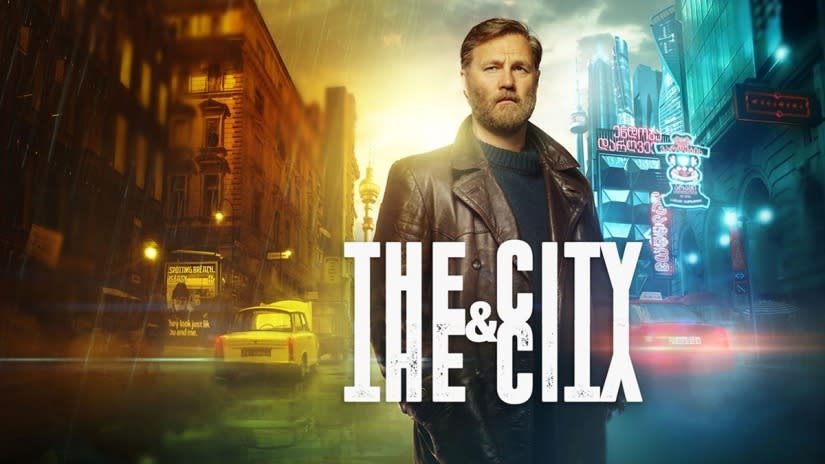How The City and the City renders the noir genre within liminal spaces

What’s most important about The City and the City is all the ways in which it’s unfamiliar.
That’s not true of everything, of course; much of it does, in fact, riff on the established tenets of the noir genre. There’s a cynical policeman, a missing wife, and a dead girl at the heart of the case. Of course, there’s also an awareness of these archetypes, a knowing acknowledgement; “why is it always a dead girl?” asks one of the characters, skewering large swathes of the genre with an offhanded comment. The City and the City is aware of what form the more pedestrian examples of its genre tend to take; in response, then, it tries to take these ideas and do something a little different.
The central conceit of the series, in a way, is about unfamiliarity. The City and the City presents us with two overlapping city-states, Besźel and Ul Qoma; they inhabit the same physical space, but are perceived as two distinct places, separated by a skin stretched across the world. There’s something impressive about how effortlessly The City and the City presents this mythology, a mythology with its own idiosyncratic language and vocabulary – immediately, and without reservation, giving the sense of a world that’s lived in and already intuitively understood by the characters we see. Similarly impressive, then, is the way the series realises this concept. Crossing over the border is an act that renders the familiar unfamiliar, and it’s an effect achieved through no small part because of Tom Shankland’s evocative direction. Where Besźel is rendered in soft beige tones and yellow light, Ul Qoma is cast in vivid scarlet and cyan; even as the two cities share their geography, they each feel distinct, with their own sharply defined identities. Peering across the breach, a transgressive act, is to confront the unfamiliar – something you know rendered differently, just out of reach.
Thus, then, it’s quickly apparent how The City and the City uses its procedural style as an avenue to present something far stranger, and in turn more interesting; there’s an exploration of a deeper concept, an idea that sets The City and the City apart from that which it would normally be classified with.

The City and the City follows Inspector Borlu, a policeman from Besźel, investigating the death of a girl from one city, who’s body was found in another. Gradually it becomes clear that the case is much wider in scope – encompassing the leadership of a fascist political party, sinister corporations, the possibility of a third city, and the disappearance of Borlu’s wife years prior.
It’s an involved yet compelling plot; there’s something deeply engaging about juxtaposition of the grander social upheaval threatened by the possible existence of Orciny, the third city, and the quieter, personal stakes invoked by Borlu’s wife. The City and the City blends the different aspects together well, presenting a story that flits at the edges of society; it takes place in liminal spaces, pushing at the edges of not just the world it creates but also its lead character. David Morrissey gives a strong performance here, anchoring and grounding the piece – much of the reason The City and the City is able to convince is because of his portrayal of Borlu, and his attitude to the city that exists in the corner of his eye. Indeed, the series is blessed with many talented actors to realise its concepts; Mandeep Dhillon stands out especially as Constable Corwi, and Lara Pulver as Borlu’s wife Katrynia is able to elevate what could have otherwise been a largely thankless role.
Admittedly, perhaps, it’s still limited in a sense. Much as the two cities are inextricably bound together, the big ideas the show puts forward are still inextricably bound with the noir genre. It’s not to the detriment of The City and the City, not at all – though there is, just a little, the desire to go a bit further, to subvert the traditions of the procedural just a little bit more. While it’s at its best when it presents audiences with something quite unlike what they’ve seen before, it’s the moments where The City and the City is most familiar that it feels somewhat less than the sum of its parts.
Yet, ultimately, The City and the City impresses a lot. It’s a skilful take on noir, one that’s able to do something new within the genre – pushing it, in a sense, to the same sort of liminal space that the series itself is set in.
Related:
Hard Sun never quite moved beyond a police procedural, and suffered as a result
Collateral is an intimate drama, fascinated by individuals and sceptical of institutions
Like this article? Hate this article? Why not follow me on twitter for more, or send me a message on facebook to tell me what you thought? You can also find more of my articles for Yahoo here, or check out my blog here.

 Yahoo Movies
Yahoo Movies 

